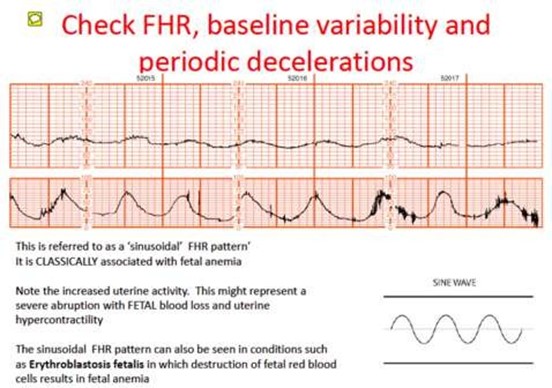A nurse is assessing the results of a nonstress test for an antepartal client at 35 weeks of gestation.
Which of the following findings should indicate to the nurse the need for further diagnostic testing?
An increase in fetal heart rate to 150/min above the baseline of 140/min lasting 10 seconds in response to fetal movement within a 40-min testing period.
No late decelerations noted with three uterine contractions of 60 seconds in
duration within a 10-min testing period.
Irregular contractions of 10 to 20 seconds in duration that are not felt by the
client.
The Correct Answer is C
A nurse assessing the results of a nonstress test for an antepartal client at 35 weeks of gestation should indicate the need for further diagnostic testing if there are no late decelerations noted with three uterine contractions of 60 seconds in duration within a 10-min testing period.

Choice A is incorrect because an increase in fetal heart rate to 150/min above the baseline of 140/min lasting 10 seconds in response to fetal movement within a 40-min testing period is a normal result.
Choice B is incorrect because irregular contractions of 10 to 20 seconds in duration that are not felt by the client do not indicate the need for further diagnostic testing.
Choice D is incorrect because three fetal movements perceived by the client in a 20-min testing period do not indicate the need for further diagnostic testing.
Nursing Test Bank
Naxlex Comprehensive Predictor Exams
Related Questions
Correct Answer is A
Explanation
This client should be reassessed by the RN prior to transfer, as worsening perineal pain may indicate a hematoma, infection, or inadequate pain management. The RN should inspect the perineum, check the vital signs, and evaluate the effectiveness of the medication.
The other options are not correct because:
B .A multigravida whose peri-pad is 1/4 saturated with lochia rubra after one hour does not need to be reassessed by the RN, as this is a normal finding for a client two hours post-birth. Lochia rubra is the red-colored vaginal discharge that contains blood and debris from the placental site, and it usually lasts for 3 to 4 days after delivery. A peri-pad that is 1/4 saturated after one hour is within the expected range of blood loss.
C. A multigravida complaining of strong afterbirth pains when breastfeeding does not need to be reassessed by the RN, as this is a normal finding for a client two hours post-birth. Afterbirth pains are cramps caused by uterine contractions that help shrink the uterus and prevent bleeding. They are more common and intense in multiparous women and during breastfeeding, as oxytocin is released and stimulates the contractions.
D. A primigravida who passed a small clot when she sat up on the edge of the bed does not need to be reassessed by the RN, as this is a normal finding for a client two hours post-birth. Small clots may form in the uterus or vagina due to pooling of blood during rest or anesthesia, and they are usually expelled when changing position or ambulating. As long as the clot is smaller than a plum and there is no excessive bleeding or pain, it is not a cause for concern.
Correct Answer is ["A","E"]
Explanation
The nurse should plan to immunize the client with the inactivated influenza vaccine (A) and the diphtheria-acellular pertussis vaccine (E).

The Centers for Disease Control and Prevention (CDC) recommends that pregnant women get two vaccines during every pregnancy: the inactivated flu vaccine and the Tdap vaccine.
The other vaccines listed are not recommended during pregnancy:
- The human papillomavirus vaccine is not recommended during pregnancy.
- The varicella vaccine is not recommended during pregnancy.
- The measles, mumps, and rubella vaccine is not recommended during pregnancy.
Whether you are a student looking to ace your exams or a practicing nurse seeking to enhance your expertise , our nursing education contents will empower you with the confidence and competence to make a difference in the lives of patients and become a respected leader in the healthcare field.
Visit Naxlex, invest in your future and unlock endless possibilities with our unparalleled nursing education contents today
Report Wrong Answer on the Current Question
Do you disagree with the answer? If yes, what is your expected answer? Explain.
Kindly be descriptive with the issue you are facing.
